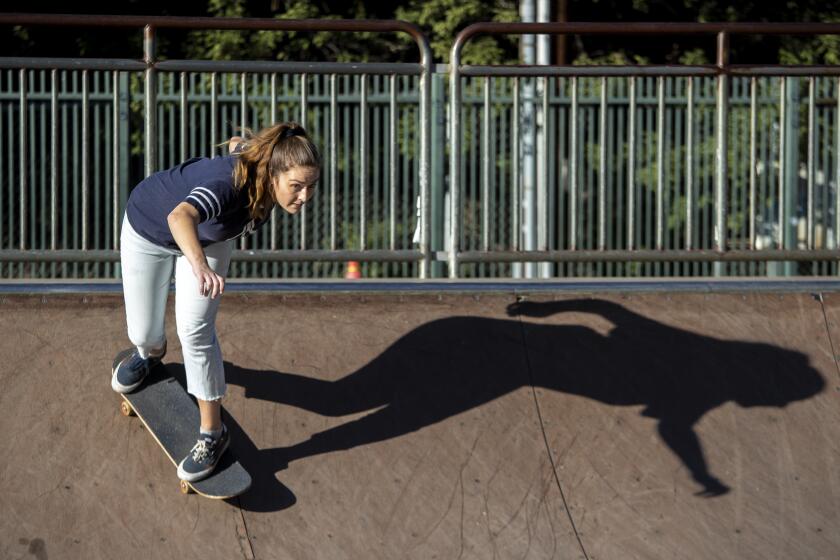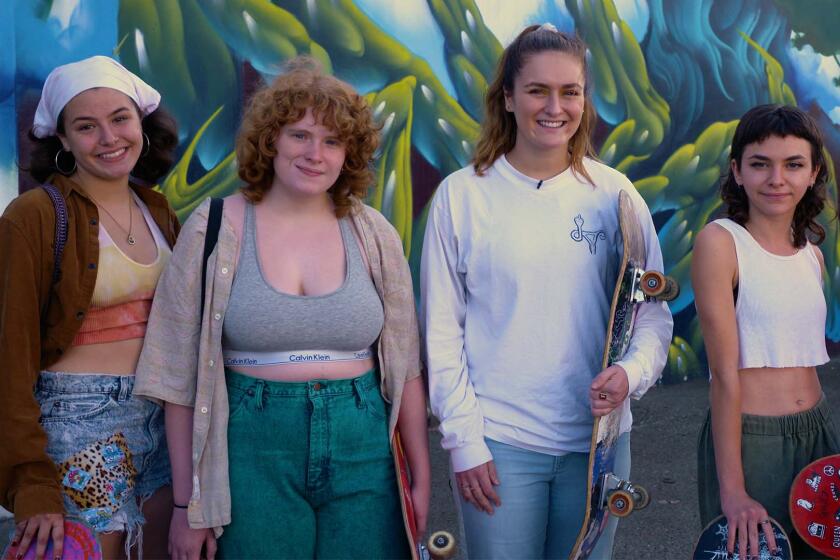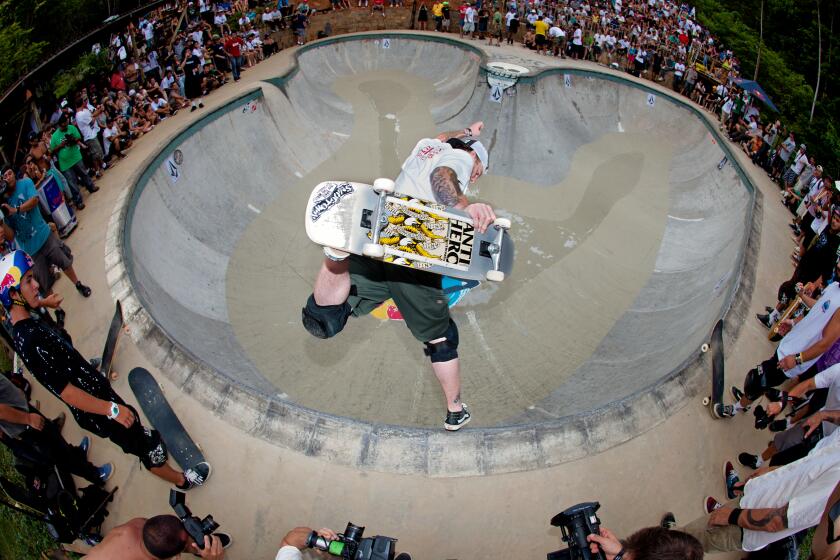
No one wanted to claim responsibility for the old parking lot. A small patch of rutted pavement, dank and filthy, it sat forgotten beneath a freeway overpass near the San Pedro docks.
Maybe it belonged to the city or the port, maybe it fell under Caltrans jurisdiction because of Interstate 110, rumbling and stinking of diesel exhaust, overhead. People started using it as a garbage dump.
All of which made the spot perfect for a group of skaters looking to ride their boards without getting hassled.
Starting around 2002, a loose collection of men and kids cleared away trash and swept away dirt, making room for an impromptu skate park, a place to bank off concrete pillars and grind across an old refrigerator toppled on its side.
“As a skateboarder, you don’t think, ‘I want to go skate a refrigerator,’ ” says Robbie O’Connell, one of the originals. “You just make use of whatever you can find.”
As word spread, the spot attained cult status. Regulars pooled their money to buy concrete and chicken wire from a Home Depot down the road, fashioning a rough, gray bump for doing ollies. Things sort of took off from there.
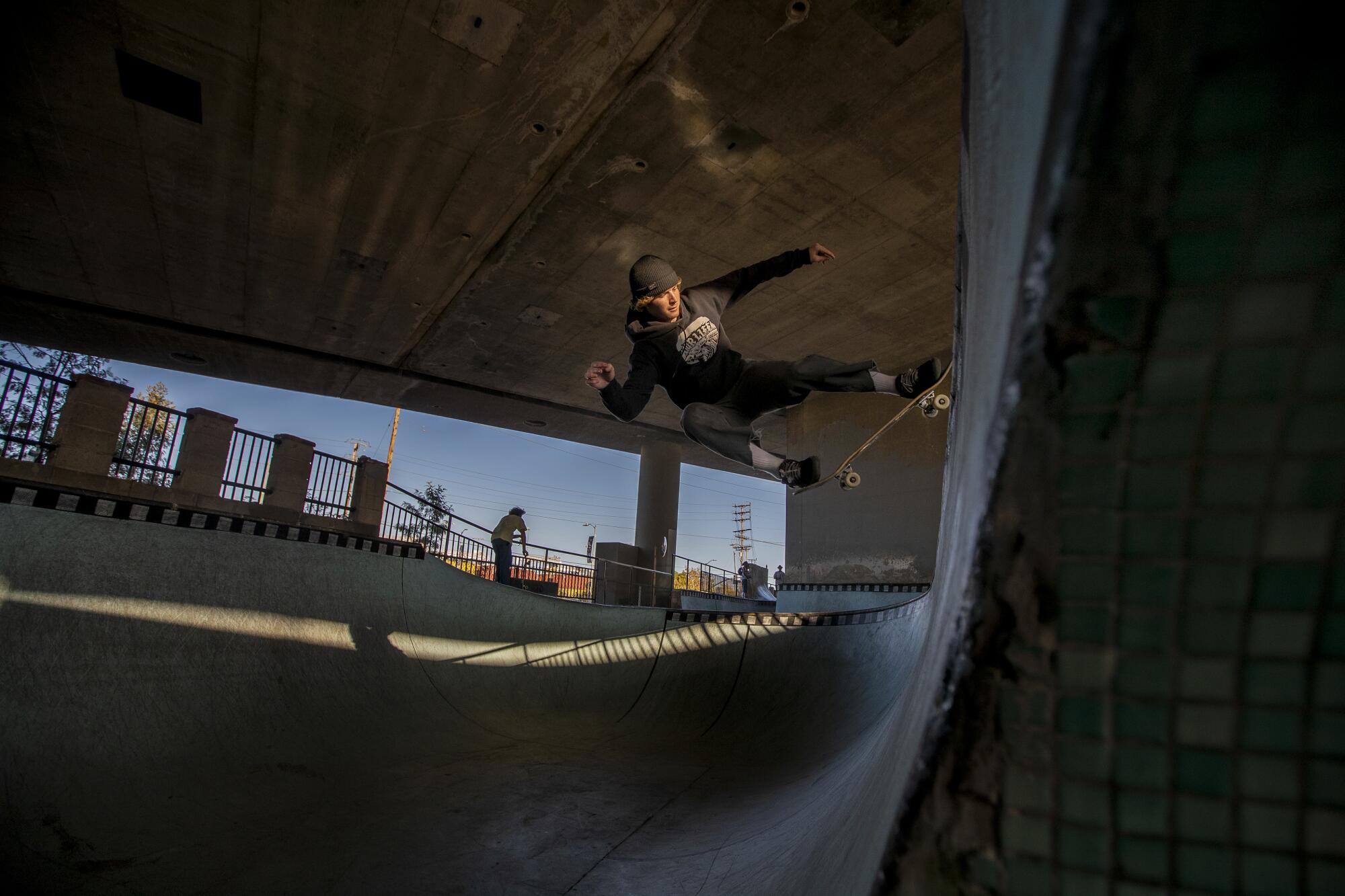
The newly dubbed Channel Street Skatepark wrangled $5,000 from a foundation run by Tony Hawk, the Michael Jordan of pro skating, and persuaded a shoe company to donate 100 yards of concrete. Local contractors volunteered their services.
“It went from one little bump to a quarter pipe and then another, rounded-off quarter pipe,” says Andy Harris, a longshoreman and skater who became the site’s unofficial mayor. “We just kept building.”
Though everyone — cops, politicians, community leaders — knew about the unpermitted construction, Channel Street thrived for a decade in its jurisdictional vacuum. It swelled to three hand-smoothed bowls, running about half the length of a football field, painted in bright colors with folk-art mosaics along the rim. A generation of young skaters grew up there, several good enough to turn professional.
Then, in 2014, their luck ran out when officials balked at being liable for the renegade skate park and shut it down. Channel Street skaters had no choice but to enter an unfamiliar world of building codes, variances and City Hall politics. It would be their hardest trick yet.
Trouble started innocently enough: The overpass needed widening, so Caltrans fenced off the area and told skaters to come back in a year. Workers filled the quarter pipes with sand to stop anyone from sneaking in on weekends.
It turned out the property, a park-and-ride lot, overlapped a railroad easement controlled by the ports of Los Angeles and Long Beach. When freeway construction ended in 2015, port authorities hesitated to let the skaters return and suggested they find another city department to assume jurisdiction.
Harris did not have the faintest idea where to begin. Looking every bit the aging skater with a grayish goatee and a ballcap tugged down over his forehead, he started visiting City Hall, talking to anyone who would listen, asking: Who can retroactively permit a do-it-yourself skate park?
“You’re trying to explain it to all these people downtown,” he says. “They look at you, and they’re like, what?”
The Channel Street saga might have ended there. As Harris puts it: “We figured it would be a matter of time before our little spot got squashed.” But things work differently in San Pedro.
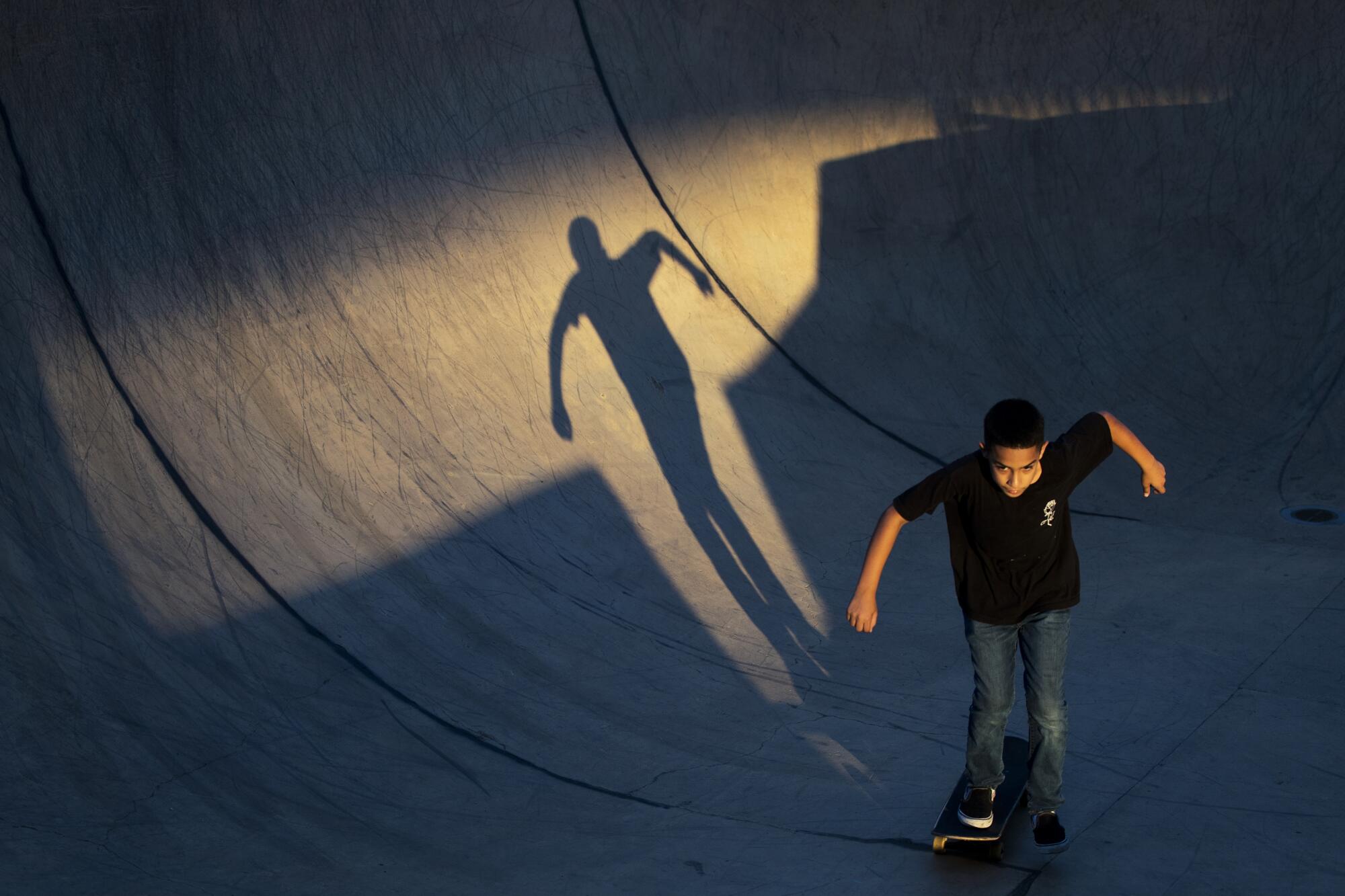
Look at a map — the community stands apart from most of L.A., 25 miles south of downtown, dangling from a narrow thread of Harbor Freeway. It is a dockworkers town and a union town that prides itself on getting things done. It is place where people see familiar faces on the street and in stores; they all knew about the skate park, made as rugged and genuine as the community itself.
When contractors noticed Harris and his friends working on the spot, they dropped off concrete and rebar left over from construction jobs. A nearby pizza joint occasionally brought over food.
As a fledgling nonprofit, the San Pedro Skatepark Assn. learned how to fundraise and earn money by renting the site for television commercials and music videos. The group transitioned from lugging sacks of concrete to ordering by the truckload.
“I was telling everybody, I’m going to chain myself to the park. Straight up, I thought about it plenty of times because, like, this is my life.”
— Robbie Russo, on his fight to save Channel Street Skatepark
A USC researcher who studies skateboarding and culture, Neftalie Williams has witnessed this dynamic at DIY skate parks in other cities. “These skaters are doing urban revitalization in a way no one else has thought about,” he says. “It helps change the stereotype of them as slackers and outsiders who aren’t interested in the community.”
San Pedro residents understood what Channel Street meant to their youth. When one of those kids, Robbie Russo, showed up as a shy 9-year-old, the older guys pulled him in and taught him to ride. They also handed him a broom because the park belonged to everyone, so everyone took turns cleaning up.
“Respect and manners,” says Russo, still a regular 21 years later. “They were like father figures, you know?”
The Channel Street familia. That’s what they called themselves.
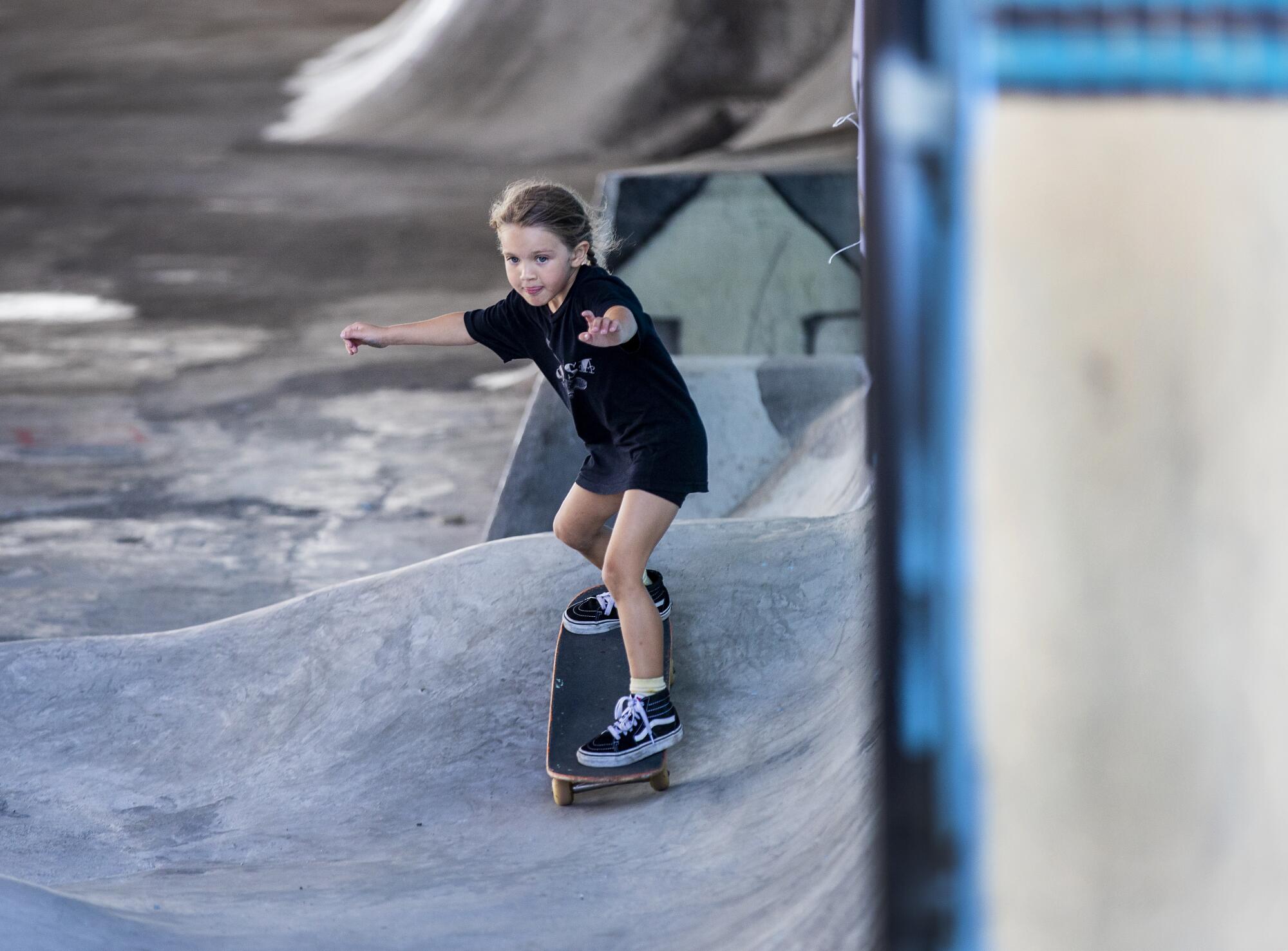
“I don’t want to sound egotistical, but we caused the opposite of problems,” O’Connell says. The longshoreman with tousled blond hair and a friendly nature gets emotional talking about his spot. “We were causing a solution.”
As the skate park fought to reopen, a planning deputy for Councilman Joe Buscaino concluded that legalizing it would require too much work with no guarantee of success. But another aide refused to let it drop.
As the councilman’s longtime spokesman, Branimir Kvartuc had grown up in San Pedro and knew the Channel Street folklore. He also recognized a good tale in the making. Kvartuc called a former colleague — and fellow harbor native — who had left government work for the private sector.
If we can get the ball rolling on this, Kvartuc said, maybe I can take it back to the boss and convince him to save Channel Street.
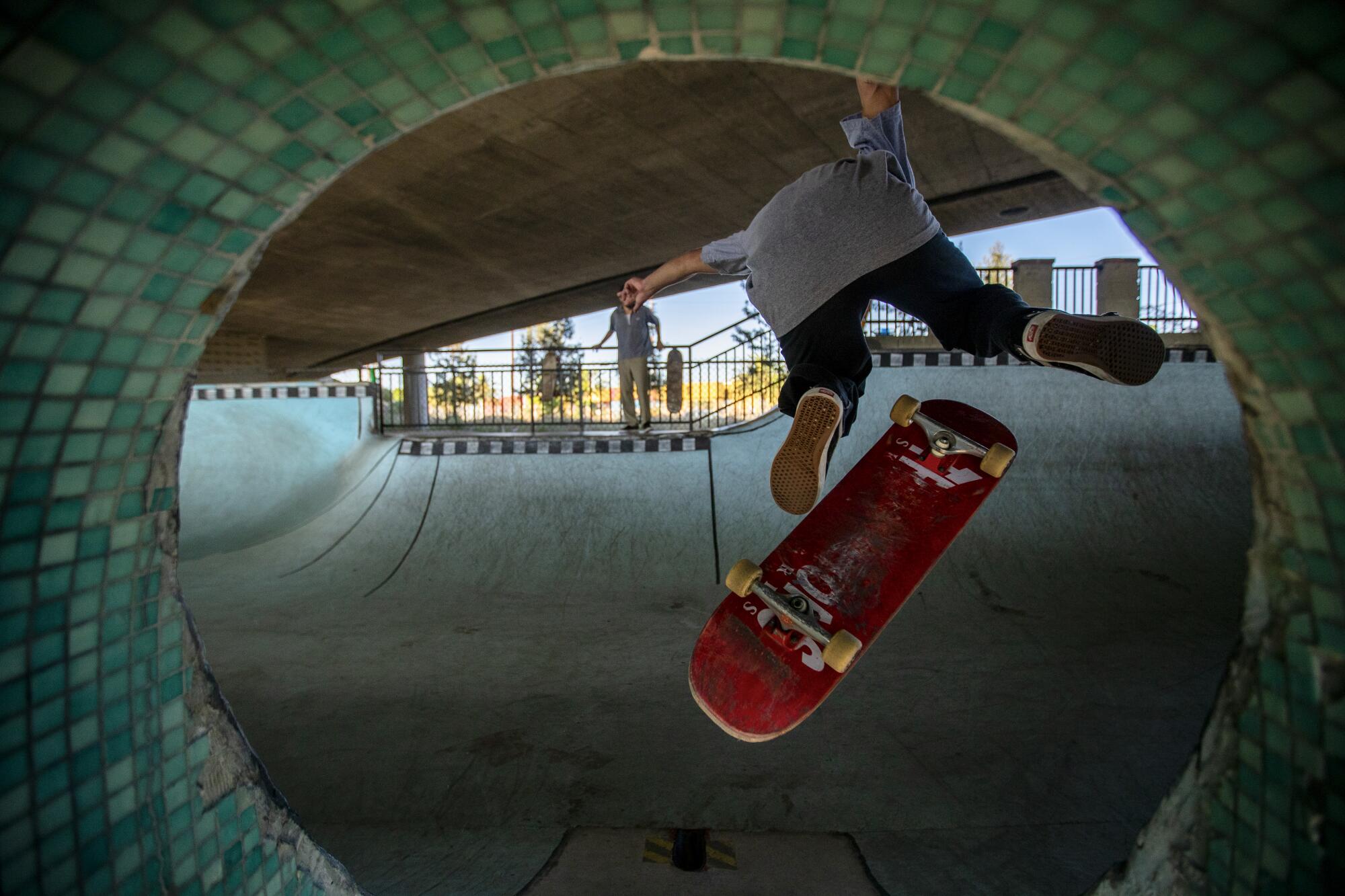
“One thing I have learned in my years growing up in San Pedro, never tell a skateboarder that something is impossible. They fall down a lot and they always get back up.”
— Joe Buscaino, L.A. City Council member
The list of municipal departments grew longer each day. Planning. Building and safety. The city attorney. Parks and recreation. The ports of L.A. and Long Beach.
Rebecca Liu had never skated but answered Kvartuc’s call for help, creating a bureaucratic roadmap and accompanying Harris to meetings where reluctant officials told them: This isn’t really my job or Sure, I like the skate park, but I’ve got bigger problems. The Channel Street familia kept pushing.
“No one wanted to put in the time to make it happen,” Liu recalls, “except for these skaters.”
Almost a year passed before she and the skaters gathered enough information to put before Buscaino, at which point they caught a break. It turned out the councilman’s nephews had skated Channel Street.
“One thing I have learned in my years growing up in San Pedro, never tell a skateboarder that something is impossible,” Buscaino says. “They fall down a lot, and they always get back up.”
The councilman assigned the case to his new planning deputy as more volunteers came aboard. A structural engineer and several architects set about reverse-engineering construction plans for something already built.
Skating is not just for white kids in the suburbs. People of color have become top competitors and more women and the LGBTQ community are joining in.
They mapped dimensions with a measuring tape and laser, created a computer drawing and drilled core samples of the concrete. X-rays revealed that contractors from years past had properly spaced the rebar and done almost everything else to code, leaving only a few needed alterations.
Workers bored drainage holes through the walls at strategic points. A sneaker company donated money to fabricate handrails along the rim.
“Feel-good story of the year, right?” O’Connell says. “You kind of see how cool humanity can be.”
But those good feelings did not last forever. Months passed between meetings, and it took even longer to obtain permits. One year became two, then three. The skaters were getting a crash course in government affairs that exasperated even the low-key Harris.
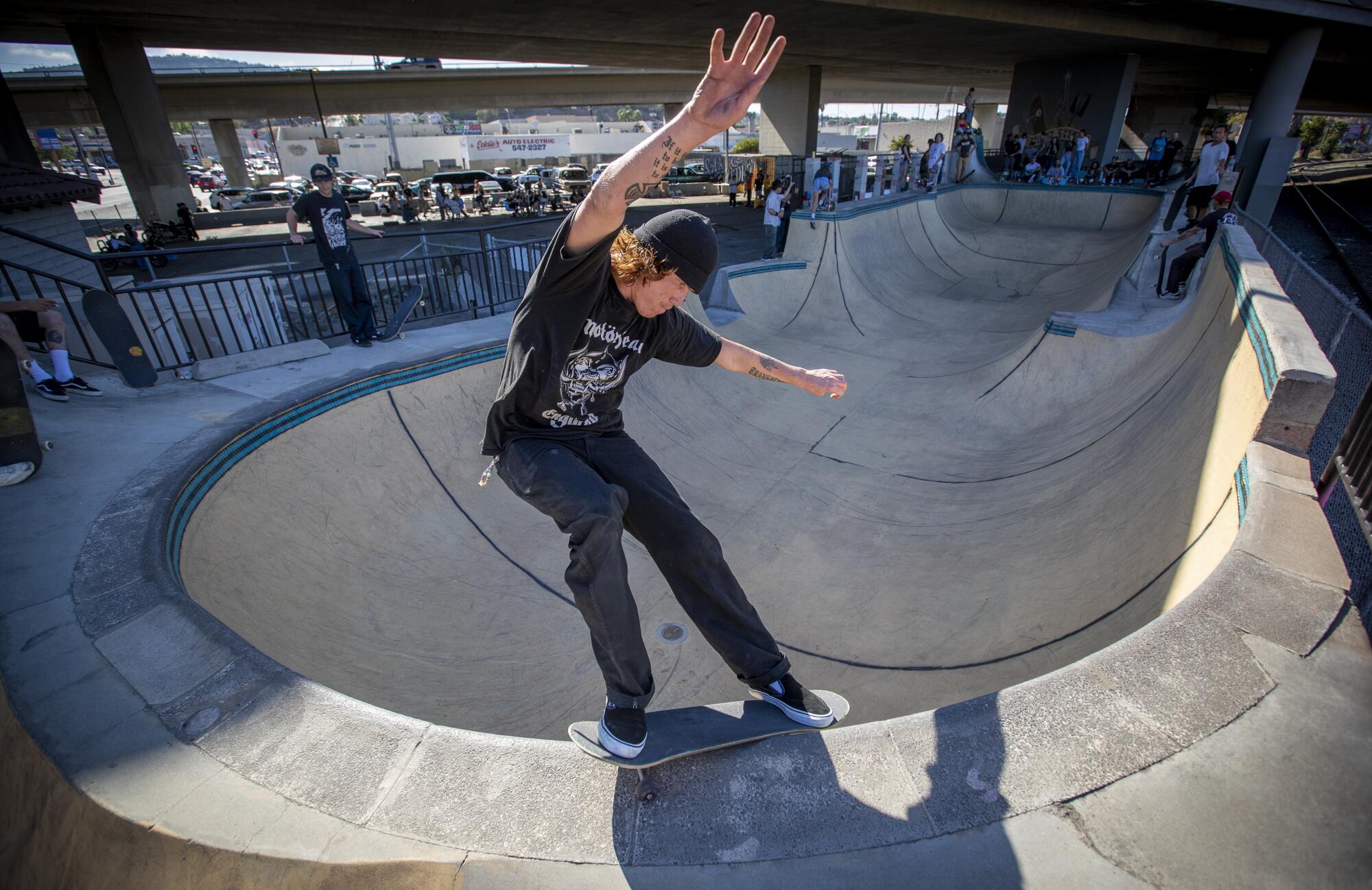
“Just that red-tape bureaucracy in a big city like Los Angeles,” he says. “There were times Branimir and I argued on the phone and hung up on each other.”
A public skate park opened nearby but did not placate anyone as Channel Street fell into disrepair, with homeless people jumping the fence, stringing makeshift roofs over the bowls. Skaters watched their beloved halfpipes fill with trash and feared the city might come through with bulldozers.
“I was telling everybody, ‘I’m going to chain myself to the park,’ ” says Russo, the former shy kid who now works for a major auto manufacturer. “Straight up, I thought about it plenty of times because, like, this is my life.”
No sport is more connected to Southern California than skateboarding. Here’s a look at the people who have helped build and grow the sport.
Kvartuc asked for patience. He can be demonstrably optimistic, wearing a big smile beneath equally large sunglasses. “If only they knew how much effort and energy we were putting into this, but they didn’t care,” he says. “They just wanted to get the job done.”
In the spring of 2018, Buscaino gave a commencement speech at San Pedro High. Hoping to impress upon graduates the value of persevering in the face of challenges, he mentioned the ongoing Channel Street project.
The crowd booed him.
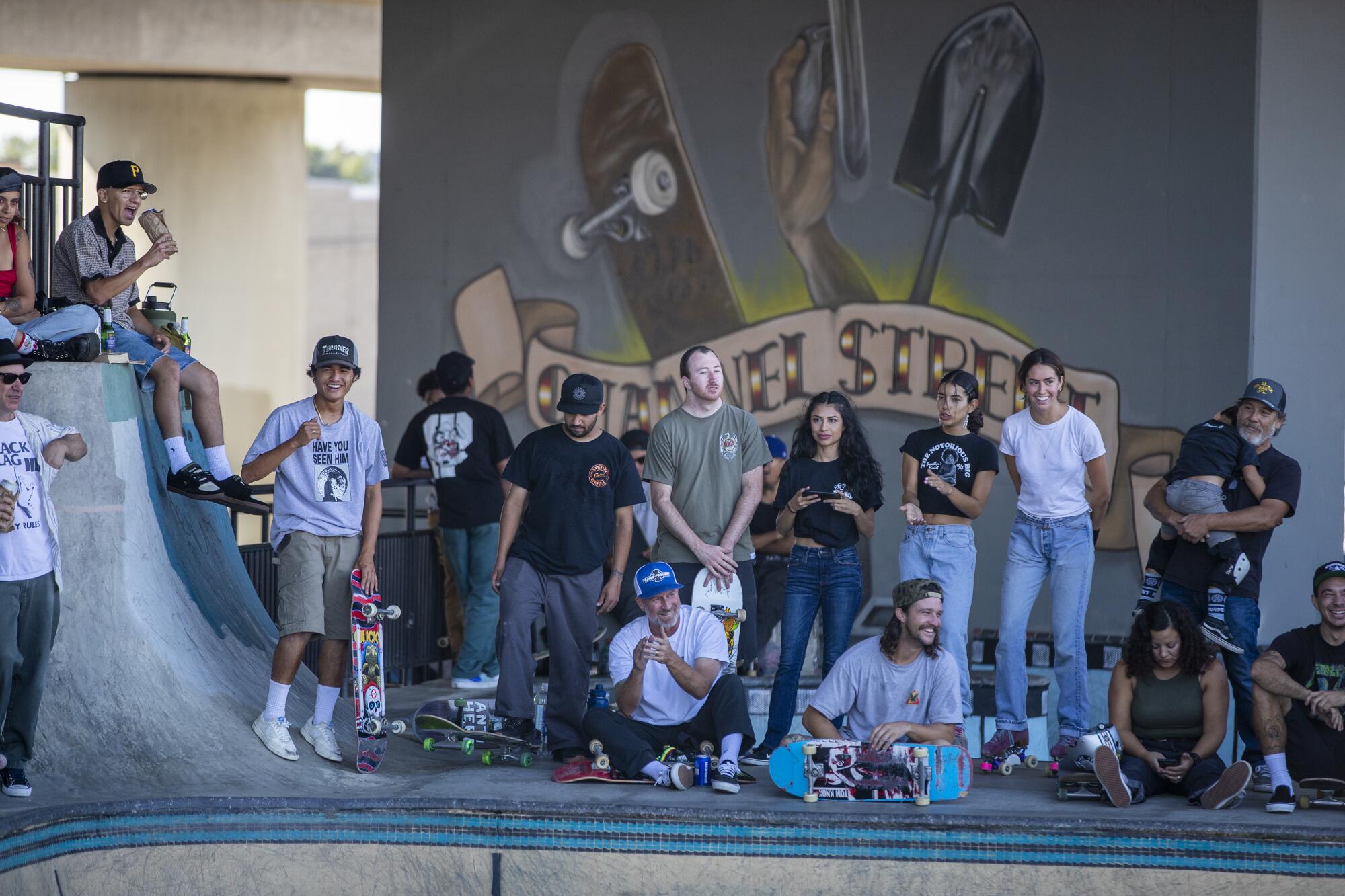
“This skatepark became an accepted part of town. It’s the makeup of this Pedro town that helped the skatepark survive.”
— Andy Harris, skater and unofficial mayor of Channel Street Skatepark
Hundreds of locals gathered in the shadow of the Channel Street overpass on a recent Sunday afternoon. Families showed up with children in tow, some with their dogs. Local businessmen came. Hot rodders lined their primer-painted cars in a row, and bikers revved their choppers as they rolled in.
Several years ago, they might have come to protest; now it was time to celebrate. An excited buzz overcame the thrum of traffic above — after eight grueling years, Building and Safety had just signed off on the skate park’s final inspection.
“We’re legal,” Harris declared from a temporary stage. “And we’re open.”
Few people outside of the skateboarding world knew of Jeff Grosso before his death a year ago of a drug overdose. Yet few led as influential a life.
It had taken a year to transfer the land from the port to the General Services department and another year to get the skate park association named as tenant on a renewable lease. A clothing company had donated money for the required insurance, trash collection and porta-potty rentals.
“This skate park became an accepted part of town,” Harris said. “It’s the makeup of this Pedro town that helped the skate park survive.”
Dressed in a T-shirt and jeans, Buscaino stepped to the microphone and suggested Channel Street serve as an example to city councils everywhere. This time he got cheers, saying if you don’t give skaters a place to ride, “they will find one and build one on their own.”
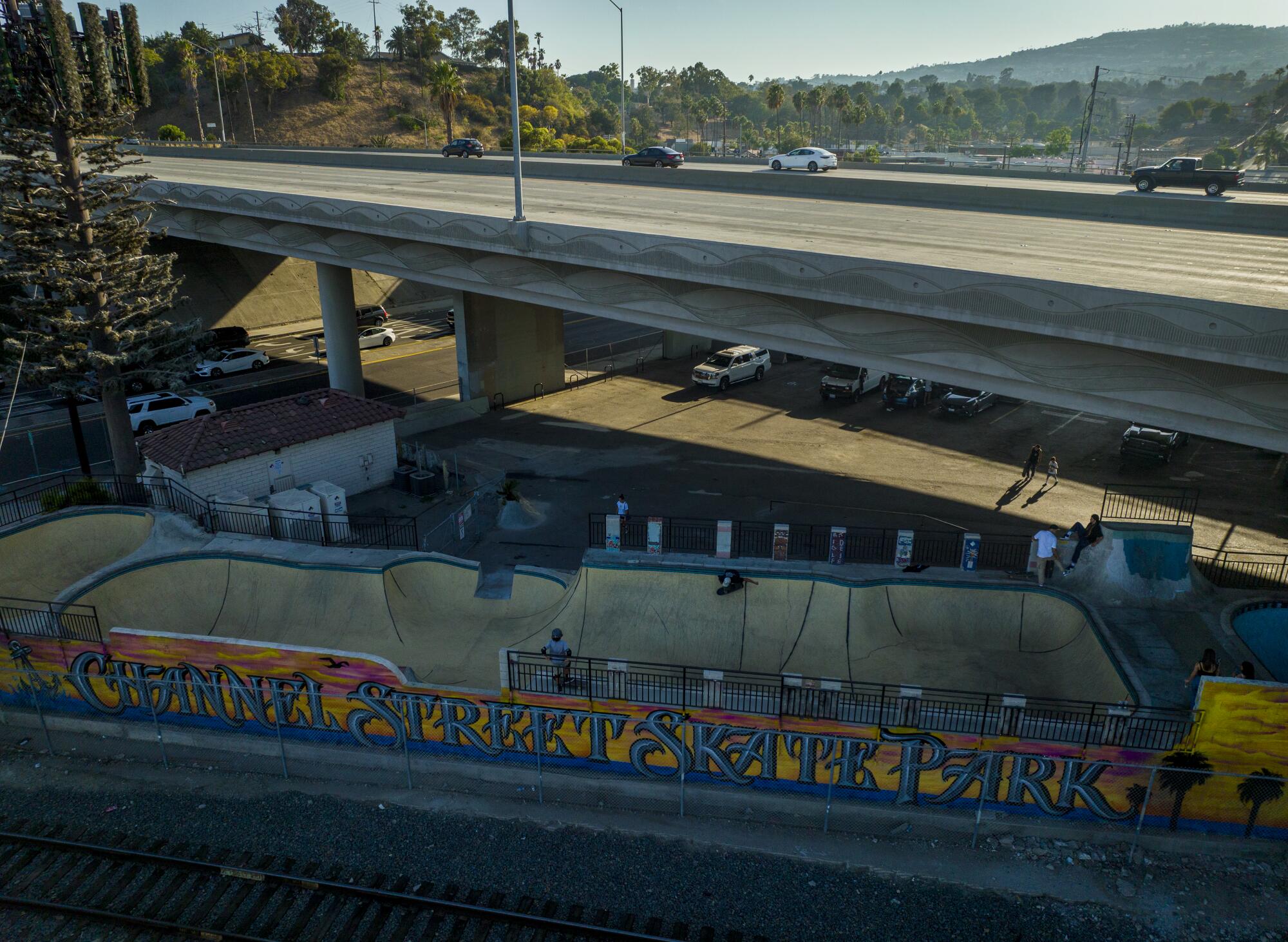
A guy from The Skatepark Project —Hawk’s foundation — asked for a show of hands from everyone one who skated, then from almost as many who had poured concrete. “This is probably the only spot where you see [that],” he said.
The speeches were brief, letting people get back to free slices from the pizza joint and free Channel Street shirts handed out by a local screen printing shop. With a ceremonial red ribbon cut, the skaters took over.
Grabbing their boards, they scrambled like ants into the bowls, climbing walls, clustering along the rim. Chatter soon gave way to a different kind of sound, every bit as joyous.
Wheels clattered and boards scraped across concrete lips. Whoops and hollers punctuated each new trick.
More to Read
Go beyond the scoreboard
Get the latest on L.A.'s teams in the daily Sports Report newsletter.
You may occasionally receive promotional content from the Los Angeles Times.

